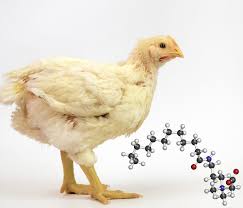Herbal Choline : New Era in Poultry
The use of high energy diets aimed at shortening the rearing period may increase metabolic disorders such as fatty liver syndrome (FLS) in broiler chickens and condition that generally affects fast growing broilers and caged layers with an inadequate chance to move and exercise freely (Jiang et al., 2013). Increased abdominal fat pad (Corduk et al., 2007), incidence of leg problems (Van Emous et al., 2015) and hypertension (Gopi et al., 2014) are some other detrimental responses associated with high energy diets. Choline is a beta-hydroxy ethyl trimethyl ammonium hydroxide. It is essential for the formation of acetylcholine, a substance that makes possible the transmission of nerve impulses. It prevents abnormal accumulation of fat (fatty livers) by promoting its transport as lecithin or by increasing the utilization of fatty acids in the liver itself (Xu et al., 2010). The supplementation of choline chloride diet improved weight gain and feed conversion efficiency in quail (Alagawany et al., 2015) and the symptoms of choline deficiency include reduced growth, fatty infiltration of liver and perosis in chicks (McDonald, 2011). Therefore, choline is referred as a “lipotropic” factor due to its function of acting on fat metabolism by hastening removal or decreasing deposition of fat in liver. Choline is a rediscovered critical amino acid for poultry and usually added to poultry diets in the form of synthetic choline chloride. However, synthetic choline chloride has several drawbacks. It is highly hygroscopic and the acceleration of oxidative loss of vitamins in the diet, and the formation of tri-methylamine in the gastrointestinal tract of the birds (Zeisel et al., 1989). Synthetic choline chloride is very less absorbed from intestine. Choline is also present in plants in the phosphatidylcholine form, free choline and sphingomyelin. Currently, there are natural products, produced from selected plants, with high content of choline in esterified form and with high bioavailability, which may be an important alternative to synthetic choline chloride. Many researchers have shown that these products can replace choline chloride in diets for poultry (Muthukumarasamy et al., 2004; Gangane et al., 2010). Sharma and Ranjan (2015) also reported that the supplementations of herbal choline can replace synthetic choline and biotin as evident by the comparable bird’s growth, viability and hypocholesterolemeic effect.
Looking at current scenario of poultry day by day feed cost is increasing. To reduce production cost replacement of certain feed additives with Herbal medicine is need of time. Various branded and trusted organizations in India are manufacturing herbal based feed supplements from the world of photochemistry. These products are highly research based products – which are exported in various countries. There is great demand for these herbal feed supplements in abroad. Still in domestic market – in India these products are not highlighted. However to control or to reduce production cost in poultry herbal feed additive is need of time. To overcome these challenges replacement of synthetic choline with Herbal choline may act as cost effective. Compositon of herbal choline is as follows: 1. Ocimum Sanctum 2. Andrographis Paniculata 3. Silybum marianum 4. Glycine Max 5. Azadirachta indica Above composition with proper portion may used as Herbal choline to replace synthetic choline.
Ocimum Sanctum:
It acts as growth promoter in poultry. The reduced oxidative stress due to supplementation of this plant to broilers is found to enhance growth rate & thus result higher body weight. The increase of body weight of chicken due to feed with ocimum sanctum containing anti-oxidants compound found in tulsi.
Andrographis paniculata:
Andrographis paniculata is medicinal plant traditionally used for treatment of cold,fever several infectious diseases in china , India and other south east Asian countries. The plant is claimed to possess immunological, anti-bacterial, anti-inflammatory and hepato protective properties.
Silybum Marianum:
Recent intensive poultry production there is great demand to use natural alternative feed additives. One of these alternative is photobiotic. Silybum Marianum is plant that has been used for many years as natural remedy for the liver diseases. Silymarin is major dried extract of silybum marianum. Silymarin has many characteristics such as antioxidant , anti-inflammatory , immune stimulant, and hepatic cell stabilizing effects. In poultry production silymarin has been used in broilers as growth promoter and in layers to improve egg quality and quantity. It has been also used as hepato tonic as a result of potent antioxidant activity. Enhancement of immune system and intestinal health observed after using of silymarin in poultry diets.
Glycine Max:
It improves feed consumption, absorption and better utilization of feed to get good FCR in poultry.
Azadirachta indica (Neem):
The active compounds found in Neem plant have wide and varied effects on human health as it is effective as it works as antimicrobial, antibacterial. Neem is perennial tree native of India also found in number of countries of south Asia. It has smell of garlic and bitter taste. Neem leaves contains antimicrobial compounds, anti-inflammatory, anti-fungal, anti-viral compounds. One of the most importantitem in neem is sodium nimbidate which is anti-inflammatory.
Compiled & Shared by- Team, LITD (Livestock Institute of Training & Development)
Image-Courtesy-Google
Reference-On Request.


